The year was 1290 . A crowd had gathered around a clearing, where broken down pillars marked the presence of an ancient temple, now long gone. A young boy, just 14 years old, leaned against one of those pillars, deep in thought. Then, he began speaking, and the crowd fell silent, listening to his every word. He spoke without any notes, translating the Bhagavat Gita, from Sanskrit, which only the pundits knew, to the language everyone in the village knew and spoke – a variety of Prakrit which developed into the Marathi language. Even as he spoke, one of the men in the audience realized how momentous this event was, and how important this composition would be. He began writing down the words the young boy spoke, and this composition was named by its author and composer, the Bhavartha Deepika – the enlightening meaning (of the Bhagavat Gita). Now, the ancient, holy text, was no longer restricted to the pundits, but accessible to all, understood easily by them, composed as it was, in their...
Recently bestowed a World Heritage Status, Dharasuram is surely one of the most beautiful temples in this area. It forms a sort of trinity along with two other grand temples – the big temple at Thanjavur and Gangaikonda Cholapuram. While it was Raja Raja Cholan who built the Brihadeeshwara Temple at Thanjavur, it was his son, Rajendra Cholan who was responsible for the beautiful architecture of Gangaikonda Cholapuram. His son, Raja Raja Cholan II is the one who built this beautiful temple at Dharasuram. Thus, across three generations, from grandfather to grandson, they kept alive the tradition of creating beauty aligned with faith, and leaving behind stones which speak more about their creators than records will ever do.
Dharasuram is the place where Indra’s elephant Airavata performed penance and was blessed by Lord Shiva. Hence the main deity is Airavateswarar, and his consort is Periyanayaki.
Here is a photo blog about this wonderful temple.
Well kept lawns welcome us to Dharasuram. This is thanks to the world heritage status
The main entrance to the temple.
Carving of chariot wheels in the temple. These are carvings on the base on which the sanctum stands.
This is the first Pragaram of the temple.
Here is the main gopuram.
One of the paintings on the outer walls of the temple
Another painting
This is a channel through which the water poured on the lingam during the abhishekam flows out into a well outside the sanctum. Look how beautifully it has been made into an arch big enough for a man to pass through.
The early morning sunrays peeping through the gopurams.
One of the smaller gopurams
Bhikshatanar on the outer wall of sanctum
Ardhanareeshwarar
Here are a few sculptures on the pillars of the main temple. They depict various scenes from day to day life.
One of the gopurams, depicting Gajalakshmi
Detail on base of the temple.
Another view of the temple
Here are a few carvings on the base of the Sannidhi. Most of them depict animals, mostly lions and elphants, with a few cows here and there.
Painting on outer wall of Sannidhi
Another painting
A sculpture on the base of Sannidhi
A parrot sits on a Nandi on the gopuram
A window carved from a single piece of stone
Here are some more carvings from the temple
This is a carving on the pillars of the Amman Sannidhi. They aren't half as ornate as those in the Shiva sannidhi.
We are back at the main entrance.
This is all that is left of the main gate of the temple. The outer pragaram, which once enclosed both the Shiva and Amman Sannidhis is no more, Till a few years back, apparently, some parts of the ruins were still standing,but now none are left, save this solitary reminder that yes, there was once a wall here.........
As we bid goodbye to this beautiful temple, we catch a glimpse of the beautiful gopuram through the trees....
Dharasuram is the place where Indra’s elephant Airavata performed penance and was blessed by Lord Shiva. Hence the main deity is Airavateswarar, and his consort is Periyanayaki.
Here is a photo blog about this wonderful temple.
| From Diwali 08 - Thanjvur Trip |
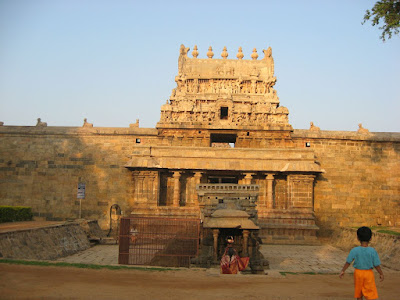 |
| From Diwali 08 - Thanjvur Trip |
 |
| From Diwali 08 - Thanjvur Trip |
 |
| From Diwal 08 Thanjavur Trip 2 |
 |
| From Diwal 08 Thanjavur Trip 2 |
 |
| From Diwal 08 Thanjavur Trip 2 |
 |
| From Diwal 08 Thanjavur Trip 2 |
 |
| From Diwal 08 Thanjavur Trip 2 |
 |
| From Diwal 08 Thanjavur Trip 2 |
 |
| From Diwal 08 Thanjavur Trip 2 |
 |
| From Diwal 08 Thanjavur Trip 2 |
 |
| From Diwal 08 Thanjavur Trip 2 |
Here are a few sculptures on the pillars of the main temple. They depict various scenes from day to day life.
 |
| From Diwal 08 Thanjavur Trip 2 |
 |
| From Diwal 08 Thanjavur Trip 2 |
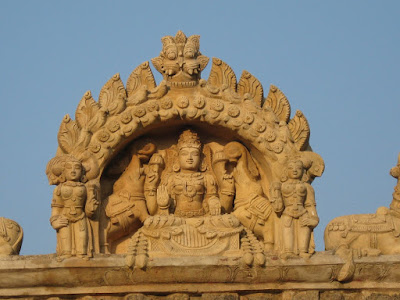 |
| From Diwal 08 Thanjavur Trip 2 |
 |
| From Diwal 08 Thanjavur Trip 2 |
 |
| From Diwal 08 Thanjavur Trip 2 |
Here are a few carvings on the base of the Sannidhi. Most of them depict animals, mostly lions and elphants, with a few cows here and there.
 |
| From Diwal 08 Thanjavur Trip 2 |
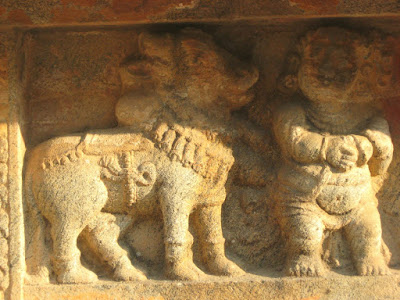 |
| From Diwal 08 Thanjavur Trip 2 |
 |
| From Diwal 08 Thanjavur Trip 2 |
 |
| From Diwal 08 Thanjavur Trip 2 |
 |
| From Diwal 08 Thanjavur Trip 2 |
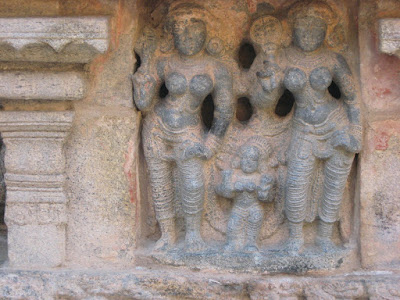 |
| From Diwal 08 Thanjavur Trip 2 |
 |
| From Diwal 08 Thanjavur Trip 2 |
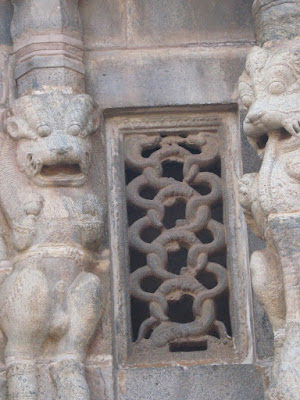 |
| From Diwal 08 Thanjavur Trip 2 |
Here are some more carvings from the temple
 |
| From Diwal 08 Thanjavur Trip 2 |
 |
| From Diwal 08 Thanjavur Trip 2 |
 |
| From Diwal 08 Thanjavur Trip 2 |
This is a carving on the pillars of the Amman Sannidhi. They aren't half as ornate as those in the Shiva sannidhi.
 |
| From Diwal 08 Thanjavur Trip 2 |
 |
| From Diwal 08 Thanjavur Trip 2 |
 |
| From Diwal 08 Thanjavur Trip 2 |
 |
| From Diwal 08 Thanjavur Trip 2 |

Comments
Post a Comment
Thanks so much for stopping by. Please leave a comment for me so that I will know you have been here....